Cross Culture Management Report 2022
VerifiedAdded on 2022/10/01
|12
|4416
|32
AI Summary
Contribute Materials
Your contribution can guide someone’s learning journey. Share your
documents today.
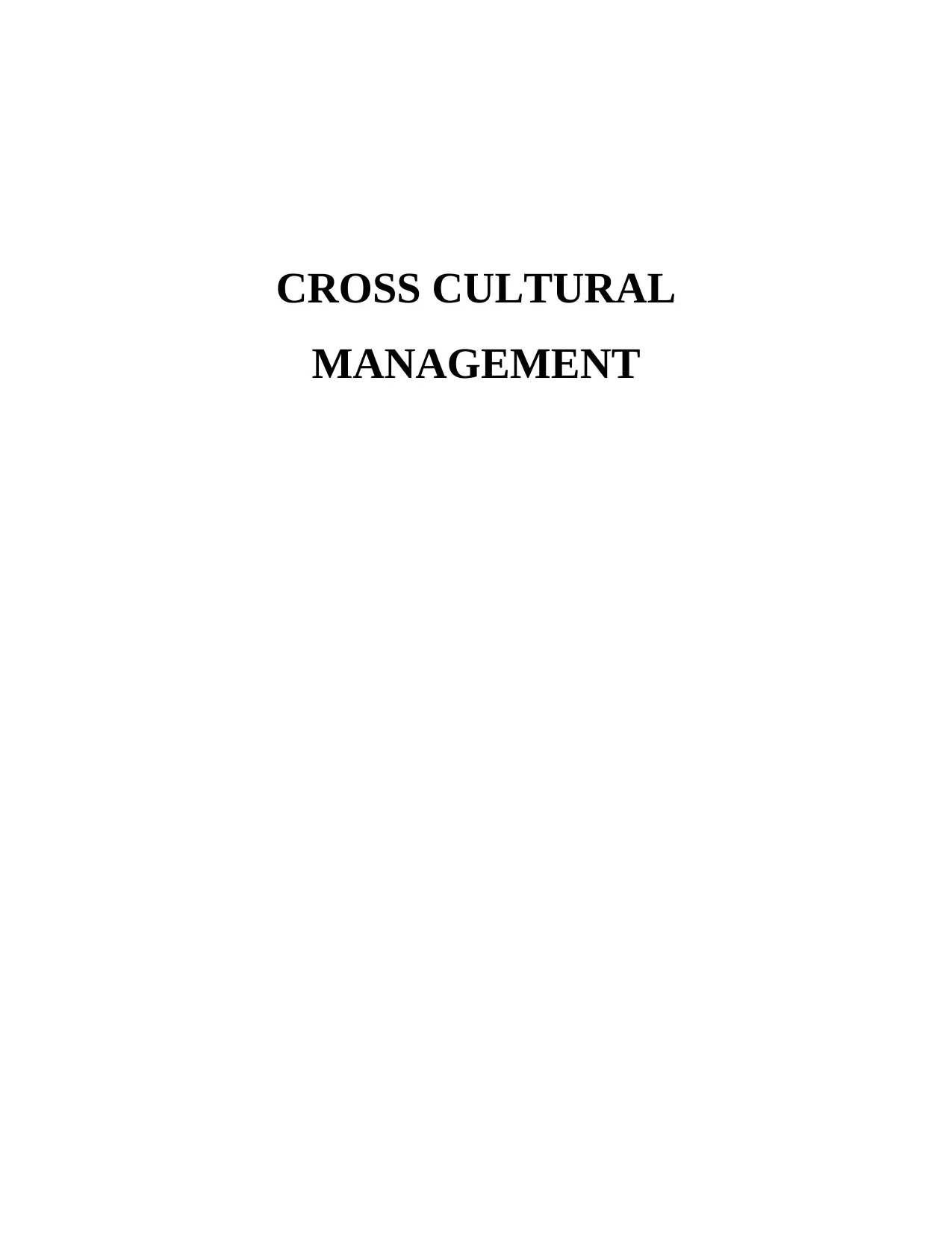
CROSS CULTURAL
MANAGEMENT
MANAGEMENT
Secure Best Marks with AI Grader
Need help grading? Try our AI Grader for instant feedback on your assignments.
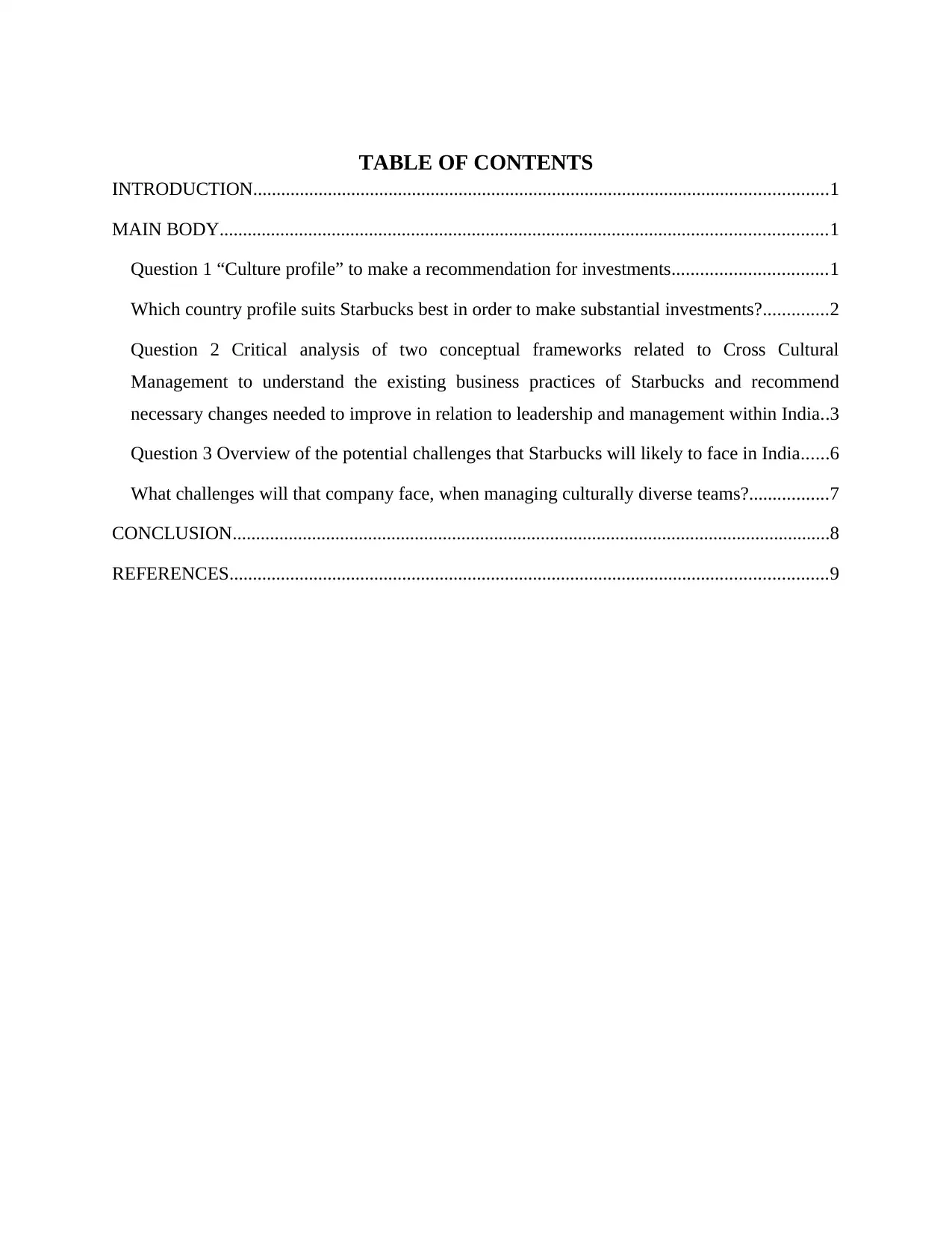
TABLE OF CONTENTS
INTRODUCTION...........................................................................................................................1
MAIN BODY..................................................................................................................................1
Question 1 “Culture profile” to make a recommendation for investments.................................1
Which country profile suits Starbucks best in order to make substantial investments?..............2
Question 2 Critical analysis of two conceptual frameworks related to Cross Cultural
Management to understand the existing business practices of Starbucks and recommend
necessary changes needed to improve in relation to leadership and management within India..3
Question 3 Overview of the potential challenges that Starbucks will likely to face in India......6
What challenges will that company face, when managing culturally diverse teams?.................7
CONCLUSION................................................................................................................................8
REFERENCES................................................................................................................................9
INTRODUCTION...........................................................................................................................1
MAIN BODY..................................................................................................................................1
Question 1 “Culture profile” to make a recommendation for investments.................................1
Which country profile suits Starbucks best in order to make substantial investments?..............2
Question 2 Critical analysis of two conceptual frameworks related to Cross Cultural
Management to understand the existing business practices of Starbucks and recommend
necessary changes needed to improve in relation to leadership and management within India..3
Question 3 Overview of the potential challenges that Starbucks will likely to face in India......6
What challenges will that company face, when managing culturally diverse teams?.................7
CONCLUSION................................................................................................................................8
REFERENCES................................................................................................................................9
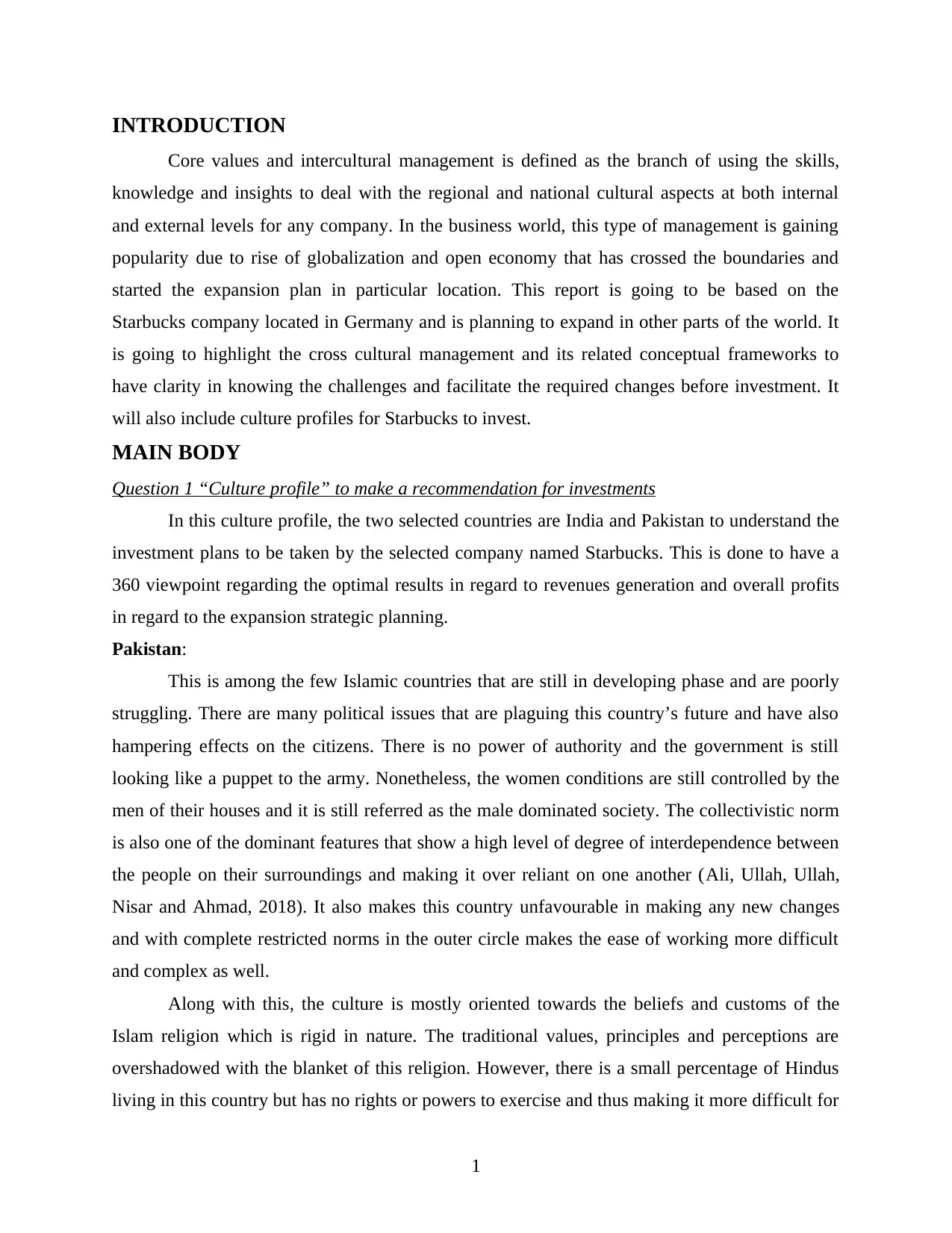
INTRODUCTION
Core values and intercultural management is defined as the branch of using the skills,
knowledge and insights to deal with the regional and national cultural aspects at both internal
and external levels for any company. In the business world, this type of management is gaining
popularity due to rise of globalization and open economy that has crossed the boundaries and
started the expansion plan in particular location. This report is going to be based on the
Starbucks company located in Germany and is planning to expand in other parts of the world. It
is going to highlight the cross cultural management and its related conceptual frameworks to
have clarity in knowing the challenges and facilitate the required changes before investment. It
will also include culture profiles for Starbucks to invest.
MAIN BODY
Question 1 “Culture profile” to make a recommendation for investments
In this culture profile, the two selected countries are India and Pakistan to understand the
investment plans to be taken by the selected company named Starbucks. This is done to have a
360 viewpoint regarding the optimal results in regard to revenues generation and overall profits
in regard to the expansion strategic planning.
Pakistan:
This is among the few Islamic countries that are still in developing phase and are poorly
struggling. There are many political issues that are plaguing this country’s future and have also
hampering effects on the citizens. There is no power of authority and the government is still
looking like a puppet to the army. Nonetheless, the women conditions are still controlled by the
men of their houses and it is still referred as the male dominated society. The collectivistic norm
is also one of the dominant features that show a high level of degree of interdependence between
the people on their surroundings and making it over reliant on one another (Ali, Ullah, Ullah,
Nisar and Ahmad, 2018). It also makes this country unfavourable in making any new changes
and with complete restricted norms in the outer circle makes the ease of working more difficult
and complex as well.
Along with this, the culture is mostly oriented towards the beliefs and customs of the
Islam religion which is rigid in nature. The traditional values, principles and perceptions are
overshadowed with the blanket of this religion. However, there is a small percentage of Hindus
living in this country but has no rights or powers to exercise and thus making it more difficult for
1
Core values and intercultural management is defined as the branch of using the skills,
knowledge and insights to deal with the regional and national cultural aspects at both internal
and external levels for any company. In the business world, this type of management is gaining
popularity due to rise of globalization and open economy that has crossed the boundaries and
started the expansion plan in particular location. This report is going to be based on the
Starbucks company located in Germany and is planning to expand in other parts of the world. It
is going to highlight the cross cultural management and its related conceptual frameworks to
have clarity in knowing the challenges and facilitate the required changes before investment. It
will also include culture profiles for Starbucks to invest.
MAIN BODY
Question 1 “Culture profile” to make a recommendation for investments
In this culture profile, the two selected countries are India and Pakistan to understand the
investment plans to be taken by the selected company named Starbucks. This is done to have a
360 viewpoint regarding the optimal results in regard to revenues generation and overall profits
in regard to the expansion strategic planning.
Pakistan:
This is among the few Islamic countries that are still in developing phase and are poorly
struggling. There are many political issues that are plaguing this country’s future and have also
hampering effects on the citizens. There is no power of authority and the government is still
looking like a puppet to the army. Nonetheless, the women conditions are still controlled by the
men of their houses and it is still referred as the male dominated society. The collectivistic norm
is also one of the dominant features that show a high level of degree of interdependence between
the people on their surroundings and making it over reliant on one another (Ali, Ullah, Ullah,
Nisar and Ahmad, 2018). It also makes this country unfavourable in making any new changes
and with complete restricted norms in the outer circle makes the ease of working more difficult
and complex as well.
Along with this, the culture is mostly oriented towards the beliefs and customs of the
Islam religion which is rigid in nature. The traditional values, principles and perceptions are
overshadowed with the blanket of this religion. However, there is a small percentage of Hindus
living in this country but has no rights or powers to exercise and thus making it more difficult for
1
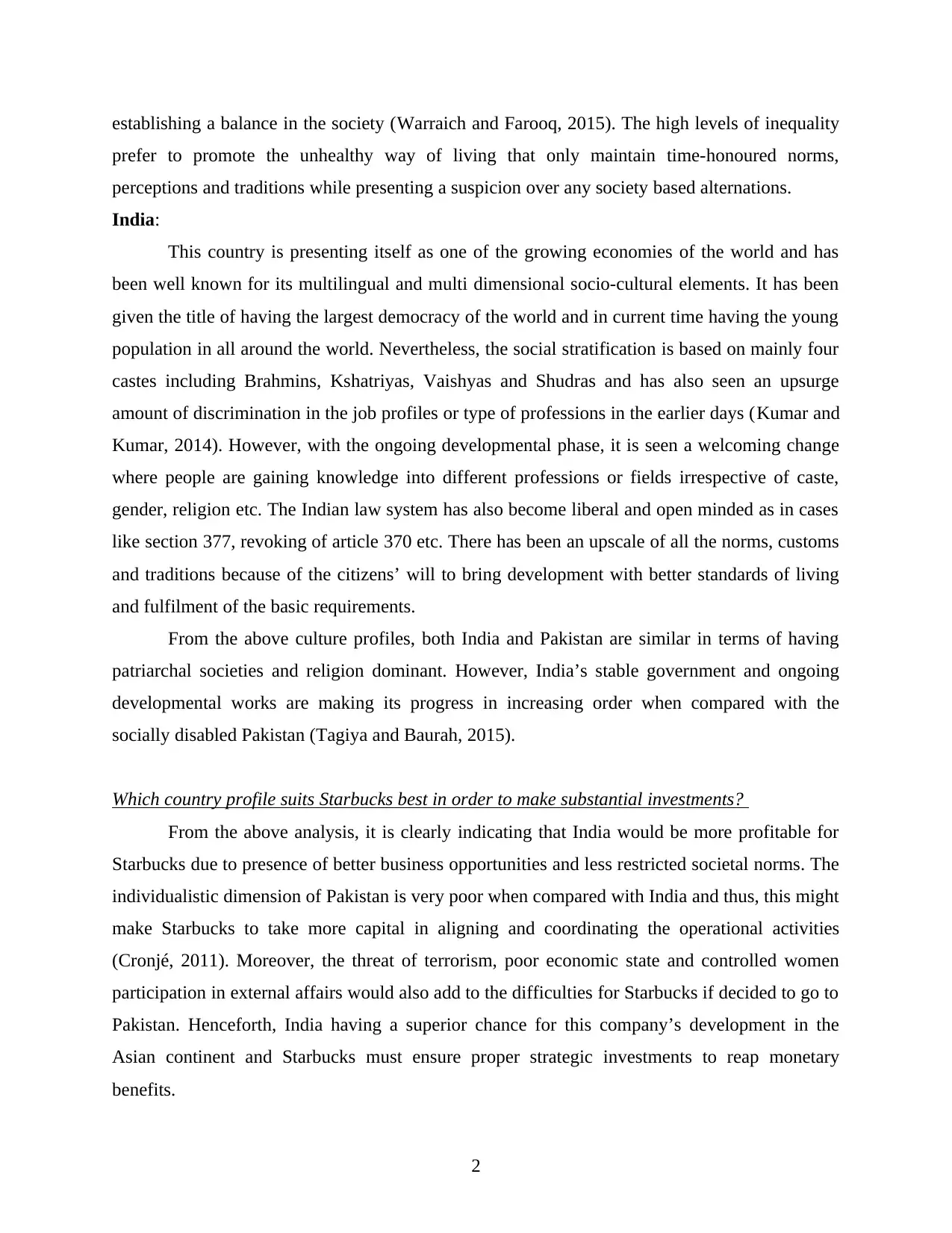
establishing a balance in the society (Warraich and Farooq, 2015). The high levels of inequality
prefer to promote the unhealthy way of living that only maintain time-honoured norms,
perceptions and traditions while presenting a suspicion over any society based alternations.
India:
This country is presenting itself as one of the growing economies of the world and has
been well known for its multilingual and multi dimensional socio-cultural elements. It has been
given the title of having the largest democracy of the world and in current time having the young
population in all around the world. Nevertheless, the social stratification is based on mainly four
castes including Brahmins, Kshatriyas, Vaishyas and Shudras and has also seen an upsurge
amount of discrimination in the job profiles or type of professions in the earlier days (Kumar and
Kumar, 2014). However, with the ongoing developmental phase, it is seen a welcoming change
where people are gaining knowledge into different professions or fields irrespective of caste,
gender, religion etc. The Indian law system has also become liberal and open minded as in cases
like section 377, revoking of article 370 etc. There has been an upscale of all the norms, customs
and traditions because of the citizens’ will to bring development with better standards of living
and fulfilment of the basic requirements.
From the above culture profiles, both India and Pakistan are similar in terms of having
patriarchal societies and religion dominant. However, India’s stable government and ongoing
developmental works are making its progress in increasing order when compared with the
socially disabled Pakistan (Tagiya and Baurah, 2015).
Which country profile suits Starbucks best in order to make substantial investments?
From the above analysis, it is clearly indicating that India would be more profitable for
Starbucks due to presence of better business opportunities and less restricted societal norms. The
individualistic dimension of Pakistan is very poor when compared with India and thus, this might
make Starbucks to take more capital in aligning and coordinating the operational activities
(Cronjé, 2011). Moreover, the threat of terrorism, poor economic state and controlled women
participation in external affairs would also add to the difficulties for Starbucks if decided to go to
Pakistan. Henceforth, India having a superior chance for this company’s development in the
Asian continent and Starbucks must ensure proper strategic investments to reap monetary
benefits.
2
prefer to promote the unhealthy way of living that only maintain time-honoured norms,
perceptions and traditions while presenting a suspicion over any society based alternations.
India:
This country is presenting itself as one of the growing economies of the world and has
been well known for its multilingual and multi dimensional socio-cultural elements. It has been
given the title of having the largest democracy of the world and in current time having the young
population in all around the world. Nevertheless, the social stratification is based on mainly four
castes including Brahmins, Kshatriyas, Vaishyas and Shudras and has also seen an upsurge
amount of discrimination in the job profiles or type of professions in the earlier days (Kumar and
Kumar, 2014). However, with the ongoing developmental phase, it is seen a welcoming change
where people are gaining knowledge into different professions or fields irrespective of caste,
gender, religion etc. The Indian law system has also become liberal and open minded as in cases
like section 377, revoking of article 370 etc. There has been an upscale of all the norms, customs
and traditions because of the citizens’ will to bring development with better standards of living
and fulfilment of the basic requirements.
From the above culture profiles, both India and Pakistan are similar in terms of having
patriarchal societies and religion dominant. However, India’s stable government and ongoing
developmental works are making its progress in increasing order when compared with the
socially disabled Pakistan (Tagiya and Baurah, 2015).
Which country profile suits Starbucks best in order to make substantial investments?
From the above analysis, it is clearly indicating that India would be more profitable for
Starbucks due to presence of better business opportunities and less restricted societal norms. The
individualistic dimension of Pakistan is very poor when compared with India and thus, this might
make Starbucks to take more capital in aligning and coordinating the operational activities
(Cronjé, 2011). Moreover, the threat of terrorism, poor economic state and controlled women
participation in external affairs would also add to the difficulties for Starbucks if decided to go to
Pakistan. Henceforth, India having a superior chance for this company’s development in the
Asian continent and Starbucks must ensure proper strategic investments to reap monetary
benefits.
2
Secure Best Marks with AI Grader
Need help grading? Try our AI Grader for instant feedback on your assignments.
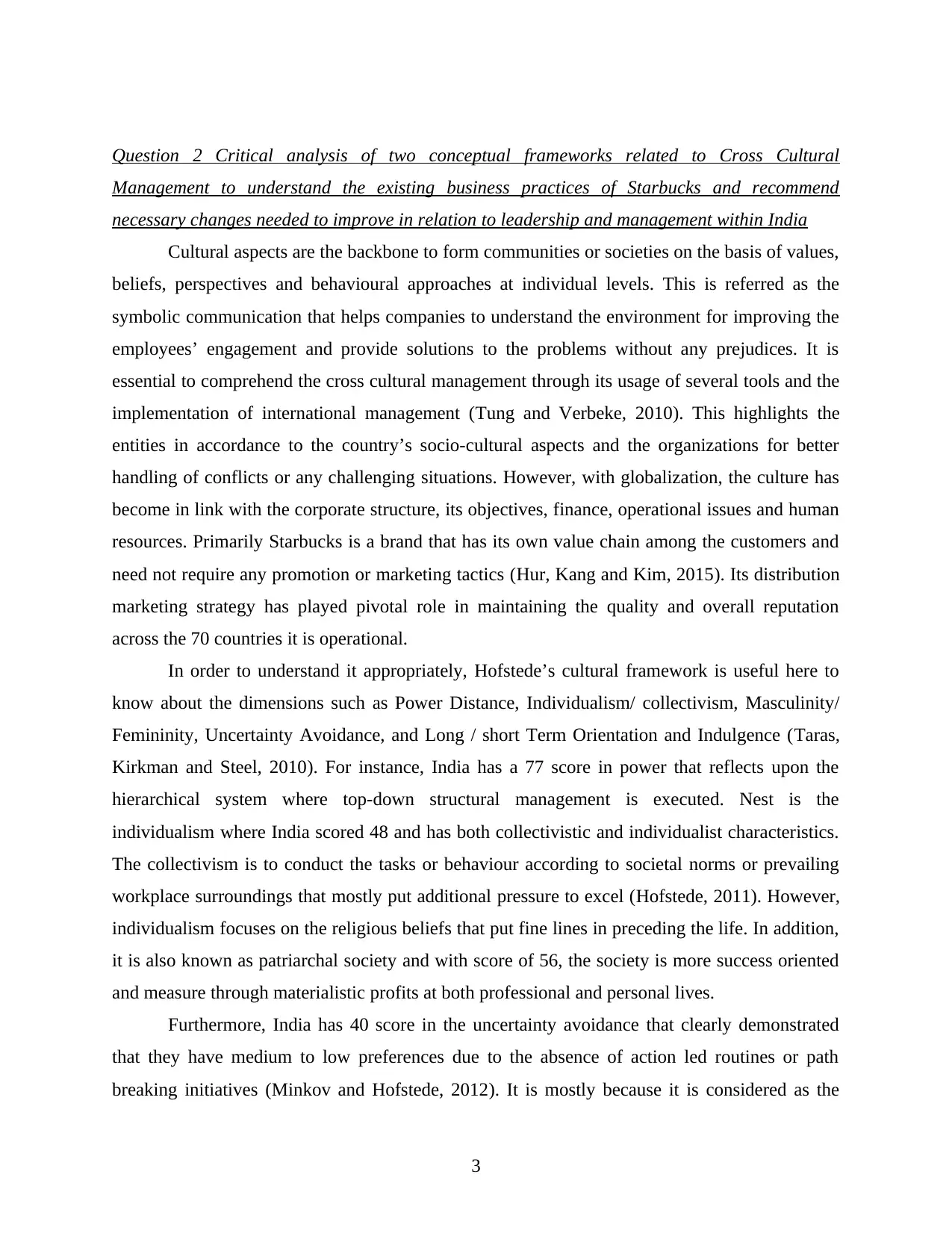
Question 2 Critical analysis of two conceptual frameworks related to Cross Cultural
Management to understand the existing business practices of Starbucks and recommend
necessary changes needed to improve in relation to leadership and management within India
Cultural aspects are the backbone to form communities or societies on the basis of values,
beliefs, perspectives and behavioural approaches at individual levels. This is referred as the
symbolic communication that helps companies to understand the environment for improving the
employees’ engagement and provide solutions to the problems without any prejudices. It is
essential to comprehend the cross cultural management through its usage of several tools and the
implementation of international management (Tung and Verbeke, 2010). This highlights the
entities in accordance to the country’s socio-cultural aspects and the organizations for better
handling of conflicts or any challenging situations. However, with globalization, the culture has
become in link with the corporate structure, its objectives, finance, operational issues and human
resources. Primarily Starbucks is a brand that has its own value chain among the customers and
need not require any promotion or marketing tactics (Hur, Kang and Kim, 2015). Its distribution
marketing strategy has played pivotal role in maintaining the quality and overall reputation
across the 70 countries it is operational.
In order to understand it appropriately, Hofstede’s cultural framework is useful here to
know about the dimensions such as Power Distance, Individualism/ collectivism, Masculinity/
Femininity, Uncertainty Avoidance, and Long / short Term Orientation and Indulgence (Taras,
Kirkman and Steel, 2010). For instance, India has a 77 score in power that reflects upon the
hierarchical system where top-down structural management is executed. Nest is the
individualism where India scored 48 and has both collectivistic and individualist characteristics.
The collectivism is to conduct the tasks or behaviour according to societal norms or prevailing
workplace surroundings that mostly put additional pressure to excel (Hofstede, 2011). However,
individualism focuses on the religious beliefs that put fine lines in preceding the life. In addition,
it is also known as patriarchal society and with score of 56, the society is more success oriented
and measure through materialistic profits at both professional and personal lives.
Furthermore, India has 40 score in the uncertainty avoidance that clearly demonstrated
that they have medium to low preferences due to the absence of action led routines or path
breaking initiatives (Minkov and Hofstede, 2012). It is mostly because it is considered as the
3
Management to understand the existing business practices of Starbucks and recommend
necessary changes needed to improve in relation to leadership and management within India
Cultural aspects are the backbone to form communities or societies on the basis of values,
beliefs, perspectives and behavioural approaches at individual levels. This is referred as the
symbolic communication that helps companies to understand the environment for improving the
employees’ engagement and provide solutions to the problems without any prejudices. It is
essential to comprehend the cross cultural management through its usage of several tools and the
implementation of international management (Tung and Verbeke, 2010). This highlights the
entities in accordance to the country’s socio-cultural aspects and the organizations for better
handling of conflicts or any challenging situations. However, with globalization, the culture has
become in link with the corporate structure, its objectives, finance, operational issues and human
resources. Primarily Starbucks is a brand that has its own value chain among the customers and
need not require any promotion or marketing tactics (Hur, Kang and Kim, 2015). Its distribution
marketing strategy has played pivotal role in maintaining the quality and overall reputation
across the 70 countries it is operational.
In order to understand it appropriately, Hofstede’s cultural framework is useful here to
know about the dimensions such as Power Distance, Individualism/ collectivism, Masculinity/
Femininity, Uncertainty Avoidance, and Long / short Term Orientation and Indulgence (Taras,
Kirkman and Steel, 2010). For instance, India has a 77 score in power that reflects upon the
hierarchical system where top-down structural management is executed. Nest is the
individualism where India scored 48 and has both collectivistic and individualist characteristics.
The collectivism is to conduct the tasks or behaviour according to societal norms or prevailing
workplace surroundings that mostly put additional pressure to excel (Hofstede, 2011). However,
individualism focuses on the religious beliefs that put fine lines in preceding the life. In addition,
it is also known as patriarchal society and with score of 56, the society is more success oriented
and measure through materialistic profits at both professional and personal lives.
Furthermore, India has 40 score in the uncertainty avoidance that clearly demonstrated
that they have medium to low preferences due to the absence of action led routines or path
breaking initiatives (Minkov and Hofstede, 2012). It is mostly because it is considered as the
3
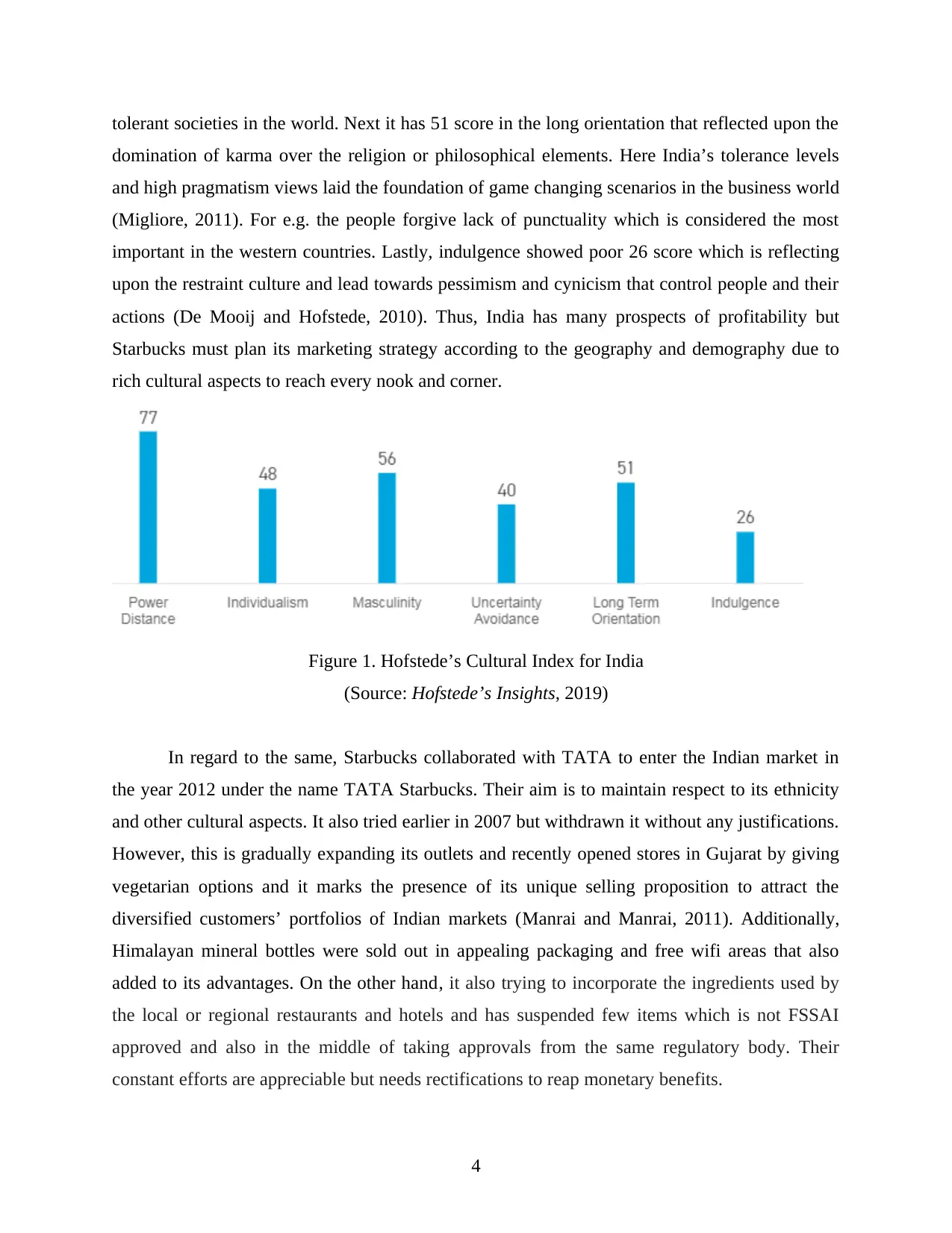
tolerant societies in the world. Next it has 51 score in the long orientation that reflected upon the
domination of karma over the religion or philosophical elements. Here India’s tolerance levels
and high pragmatism views laid the foundation of game changing scenarios in the business world
(Migliore, 2011). For e.g. the people forgive lack of punctuality which is considered the most
important in the western countries. Lastly, indulgence showed poor 26 score which is reflecting
upon the restraint culture and lead towards pessimism and cynicism that control people and their
actions (De Mooij and Hofstede, 2010). Thus, India has many prospects of profitability but
Starbucks must plan its marketing strategy according to the geography and demography due to
rich cultural aspects to reach every nook and corner.
Figure 1. Hofstede’s Cultural Index for India
(Source: Hofstede’s Insights, 2019)
In regard to the same, Starbucks collaborated with TATA to enter the Indian market in
the year 2012 under the name TATA Starbucks. Their aim is to maintain respect to its ethnicity
and other cultural aspects. It also tried earlier in 2007 but withdrawn it without any justifications.
However, this is gradually expanding its outlets and recently opened stores in Gujarat by giving
vegetarian options and it marks the presence of its unique selling proposition to attract the
diversified customers’ portfolios of Indian markets (Manrai and Manrai, 2011). Additionally,
Himalayan mineral bottles were sold out in appealing packaging and free wifi areas that also
added to its advantages. On the other hand, it also trying to incorporate the ingredients used by
the local or regional restaurants and hotels and has suspended few items which is not FSSAI
approved and also in the middle of taking approvals from the same regulatory body. Their
constant efforts are appreciable but needs rectifications to reap monetary benefits.
4
domination of karma over the religion or philosophical elements. Here India’s tolerance levels
and high pragmatism views laid the foundation of game changing scenarios in the business world
(Migliore, 2011). For e.g. the people forgive lack of punctuality which is considered the most
important in the western countries. Lastly, indulgence showed poor 26 score which is reflecting
upon the restraint culture and lead towards pessimism and cynicism that control people and their
actions (De Mooij and Hofstede, 2010). Thus, India has many prospects of profitability but
Starbucks must plan its marketing strategy according to the geography and demography due to
rich cultural aspects to reach every nook and corner.
Figure 1. Hofstede’s Cultural Index for India
(Source: Hofstede’s Insights, 2019)
In regard to the same, Starbucks collaborated with TATA to enter the Indian market in
the year 2012 under the name TATA Starbucks. Their aim is to maintain respect to its ethnicity
and other cultural aspects. It also tried earlier in 2007 but withdrawn it without any justifications.
However, this is gradually expanding its outlets and recently opened stores in Gujarat by giving
vegetarian options and it marks the presence of its unique selling proposition to attract the
diversified customers’ portfolios of Indian markets (Manrai and Manrai, 2011). Additionally,
Himalayan mineral bottles were sold out in appealing packaging and free wifi areas that also
added to its advantages. On the other hand, it also trying to incorporate the ingredients used by
the local or regional restaurants and hotels and has suspended few items which is not FSSAI
approved and also in the middle of taking approvals from the same regulatory body. Their
constant efforts are appreciable but needs rectifications to reap monetary benefits.
4
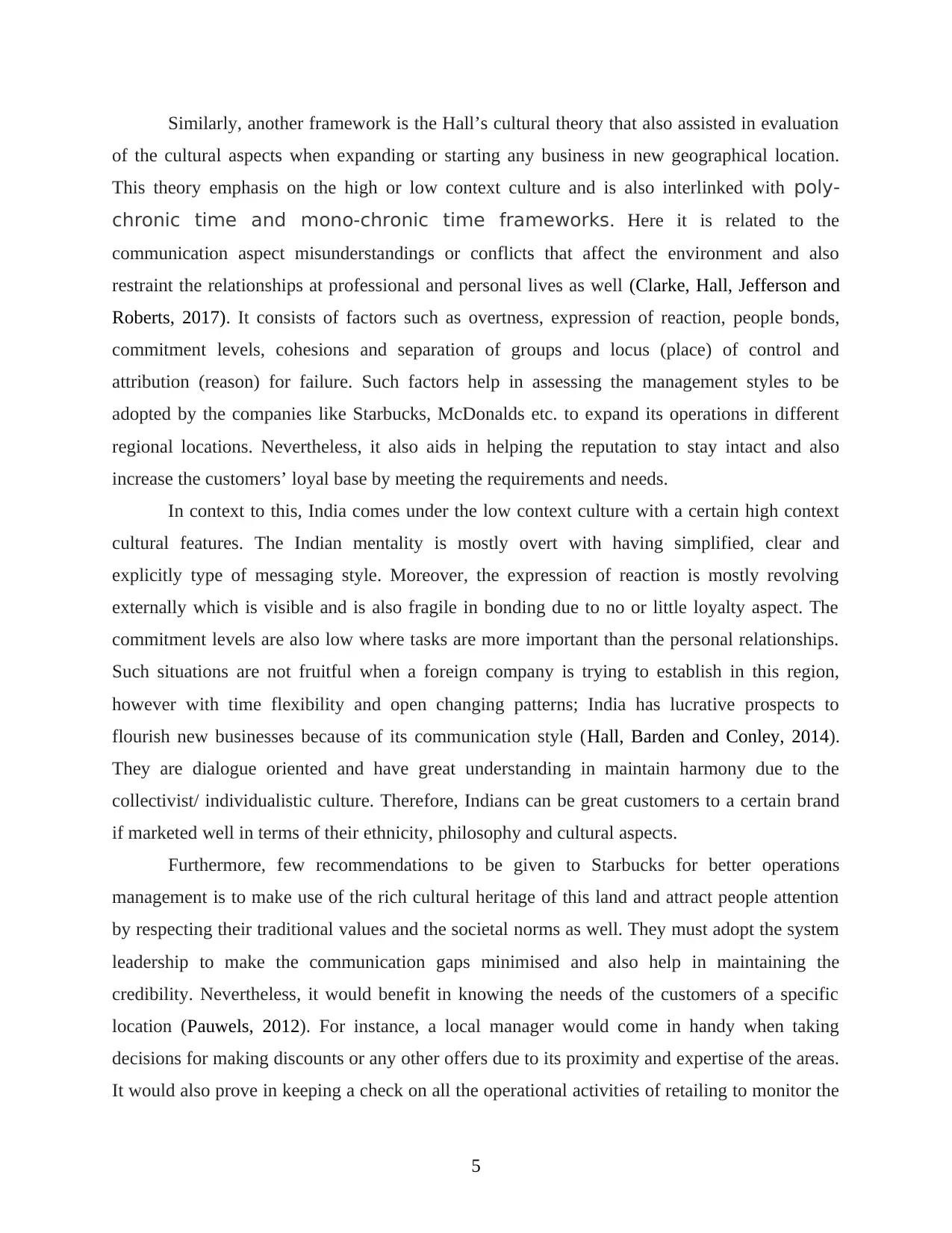
Similarly, another framework is the Hall’s cultural theory that also assisted in evaluation
of the cultural aspects when expanding or starting any business in new geographical location.
This theory emphasis on the high or low context culture and is also interlinked with poly-
chronic time and mono-chronic time frameworks. Here it is related to the
communication aspect misunderstandings or conflicts that affect the environment and also
restraint the relationships at professional and personal lives as well (Clarke, Hall, Jefferson and
Roberts, 2017). It consists of factors such as overtness, expression of reaction, people bonds,
commitment levels, cohesions and separation of groups and locus (place) of control and
attribution (reason) for failure. Such factors help in assessing the management styles to be
adopted by the companies like Starbucks, McDonalds etc. to expand its operations in different
regional locations. Nevertheless, it also aids in helping the reputation to stay intact and also
increase the customers’ loyal base by meeting the requirements and needs.
In context to this, India comes under the low context culture with a certain high context
cultural features. The Indian mentality is mostly overt with having simplified, clear and
explicitly type of messaging style. Moreover, the expression of reaction is mostly revolving
externally which is visible and is also fragile in bonding due to no or little loyalty aspect. The
commitment levels are also low where tasks are more important than the personal relationships.
Such situations are not fruitful when a foreign company is trying to establish in this region,
however with time flexibility and open changing patterns; India has lucrative prospects to
flourish new businesses because of its communication style (Hall, Barden and Conley, 2014).
They are dialogue oriented and have great understanding in maintain harmony due to the
collectivist/ individualistic culture. Therefore, Indians can be great customers to a certain brand
if marketed well in terms of their ethnicity, philosophy and cultural aspects.
Furthermore, few recommendations to be given to Starbucks for better operations
management is to make use of the rich cultural heritage of this land and attract people attention
by respecting their traditional values and the societal norms as well. They must adopt the system
leadership to make the communication gaps minimised and also help in maintaining the
credibility. Nevertheless, it would benefit in knowing the needs of the customers of a specific
location (Pauwels, 2012). For instance, a local manager would come in handy when taking
decisions for making discounts or any other offers due to its proximity and expertise of the areas.
It would also prove in keeping a check on all the operational activities of retailing to monitor the
5
of the cultural aspects when expanding or starting any business in new geographical location.
This theory emphasis on the high or low context culture and is also interlinked with poly-
chronic time and mono-chronic time frameworks. Here it is related to the
communication aspect misunderstandings or conflicts that affect the environment and also
restraint the relationships at professional and personal lives as well (Clarke, Hall, Jefferson and
Roberts, 2017). It consists of factors such as overtness, expression of reaction, people bonds,
commitment levels, cohesions and separation of groups and locus (place) of control and
attribution (reason) for failure. Such factors help in assessing the management styles to be
adopted by the companies like Starbucks, McDonalds etc. to expand its operations in different
regional locations. Nevertheless, it also aids in helping the reputation to stay intact and also
increase the customers’ loyal base by meeting the requirements and needs.
In context to this, India comes under the low context culture with a certain high context
cultural features. The Indian mentality is mostly overt with having simplified, clear and
explicitly type of messaging style. Moreover, the expression of reaction is mostly revolving
externally which is visible and is also fragile in bonding due to no or little loyalty aspect. The
commitment levels are also low where tasks are more important than the personal relationships.
Such situations are not fruitful when a foreign company is trying to establish in this region,
however with time flexibility and open changing patterns; India has lucrative prospects to
flourish new businesses because of its communication style (Hall, Barden and Conley, 2014).
They are dialogue oriented and have great understanding in maintain harmony due to the
collectivist/ individualistic culture. Therefore, Indians can be great customers to a certain brand
if marketed well in terms of their ethnicity, philosophy and cultural aspects.
Furthermore, few recommendations to be given to Starbucks for better operations
management is to make use of the rich cultural heritage of this land and attract people attention
by respecting their traditional values and the societal norms as well. They must adopt the system
leadership to make the communication gaps minimised and also help in maintaining the
credibility. Nevertheless, it would benefit in knowing the needs of the customers of a specific
location (Pauwels, 2012). For instance, a local manager would come in handy when taking
decisions for making discounts or any other offers due to its proximity and expertise of the areas.
It would also prove in keeping a check on all the operational activities of retailing to monitor the
5
Paraphrase This Document
Need a fresh take? Get an instant paraphrase of this document with our AI Paraphraser
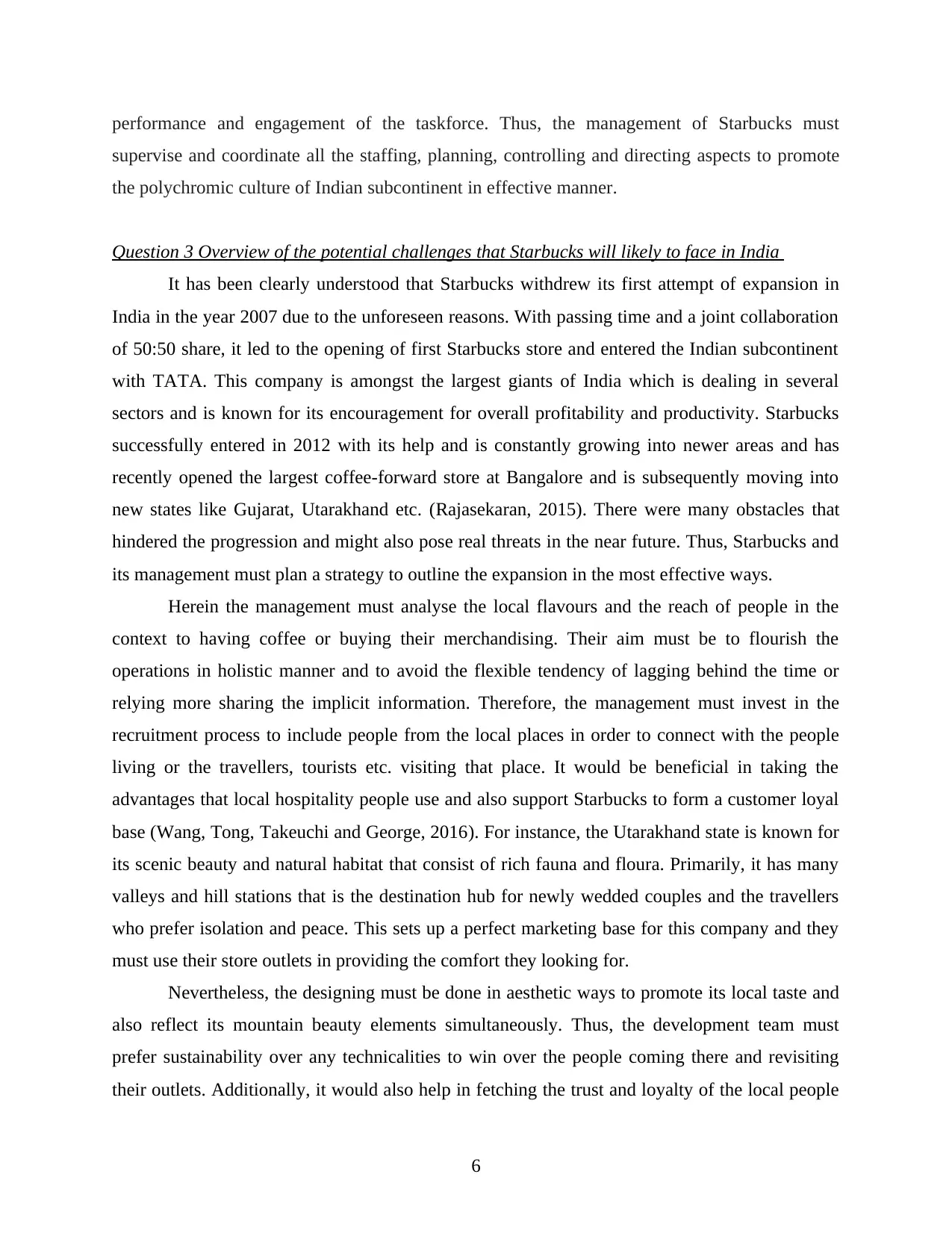
performance and engagement of the taskforce. Thus, the management of Starbucks must
supervise and coordinate all the staffing, planning, controlling and directing aspects to promote
the polychromic culture of Indian subcontinent in effective manner.
Question 3 Overview of the potential challenges that Starbucks will likely to face in India
It has been clearly understood that Starbucks withdrew its first attempt of expansion in
India in the year 2007 due to the unforeseen reasons. With passing time and a joint collaboration
of 50:50 share, it led to the opening of first Starbucks store and entered the Indian subcontinent
with TATA. This company is amongst the largest giants of India which is dealing in several
sectors and is known for its encouragement for overall profitability and productivity. Starbucks
successfully entered in 2012 with its help and is constantly growing into newer areas and has
recently opened the largest coffee-forward store at Bangalore and is subsequently moving into
new states like Gujarat, Utarakhand etc. (Rajasekaran, 2015). There were many obstacles that
hindered the progression and might also pose real threats in the near future. Thus, Starbucks and
its management must plan a strategy to outline the expansion in the most effective ways.
Herein the management must analyse the local flavours and the reach of people in the
context to having coffee or buying their merchandising. Their aim must be to flourish the
operations in holistic manner and to avoid the flexible tendency of lagging behind the time or
relying more sharing the implicit information. Therefore, the management must invest in the
recruitment process to include people from the local places in order to connect with the people
living or the travellers, tourists etc. visiting that place. It would be beneficial in taking the
advantages that local hospitality people use and also support Starbucks to form a customer loyal
base (Wang, Tong, Takeuchi and George, 2016). For instance, the Utarakhand state is known for
its scenic beauty and natural habitat that consist of rich fauna and floura. Primarily, it has many
valleys and hill stations that is the destination hub for newly wedded couples and the travellers
who prefer isolation and peace. This sets up a perfect marketing base for this company and they
must use their store outlets in providing the comfort they looking for.
Nevertheless, the designing must be done in aesthetic ways to promote its local taste and
also reflect its mountain beauty elements simultaneously. Thus, the development team must
prefer sustainability over any technicalities to win over the people coming there and revisiting
their outlets. Additionally, it would also help in fetching the trust and loyalty of the local people
6
supervise and coordinate all the staffing, planning, controlling and directing aspects to promote
the polychromic culture of Indian subcontinent in effective manner.
Question 3 Overview of the potential challenges that Starbucks will likely to face in India
It has been clearly understood that Starbucks withdrew its first attempt of expansion in
India in the year 2007 due to the unforeseen reasons. With passing time and a joint collaboration
of 50:50 share, it led to the opening of first Starbucks store and entered the Indian subcontinent
with TATA. This company is amongst the largest giants of India which is dealing in several
sectors and is known for its encouragement for overall profitability and productivity. Starbucks
successfully entered in 2012 with its help and is constantly growing into newer areas and has
recently opened the largest coffee-forward store at Bangalore and is subsequently moving into
new states like Gujarat, Utarakhand etc. (Rajasekaran, 2015). There were many obstacles that
hindered the progression and might also pose real threats in the near future. Thus, Starbucks and
its management must plan a strategy to outline the expansion in the most effective ways.
Herein the management must analyse the local flavours and the reach of people in the
context to having coffee or buying their merchandising. Their aim must be to flourish the
operations in holistic manner and to avoid the flexible tendency of lagging behind the time or
relying more sharing the implicit information. Therefore, the management must invest in the
recruitment process to include people from the local places in order to connect with the people
living or the travellers, tourists etc. visiting that place. It would be beneficial in taking the
advantages that local hospitality people use and also support Starbucks to form a customer loyal
base (Wang, Tong, Takeuchi and George, 2016). For instance, the Utarakhand state is known for
its scenic beauty and natural habitat that consist of rich fauna and floura. Primarily, it has many
valleys and hill stations that is the destination hub for newly wedded couples and the travellers
who prefer isolation and peace. This sets up a perfect marketing base for this company and they
must use their store outlets in providing the comfort they looking for.
Nevertheless, the designing must be done in aesthetic ways to promote its local taste and
also reflect its mountain beauty elements simultaneously. Thus, the development team must
prefer sustainability over any technicalities to win over the people coming there and revisiting
their outlets. Additionally, it would also help in fetching the trust and loyalty of the local people
6
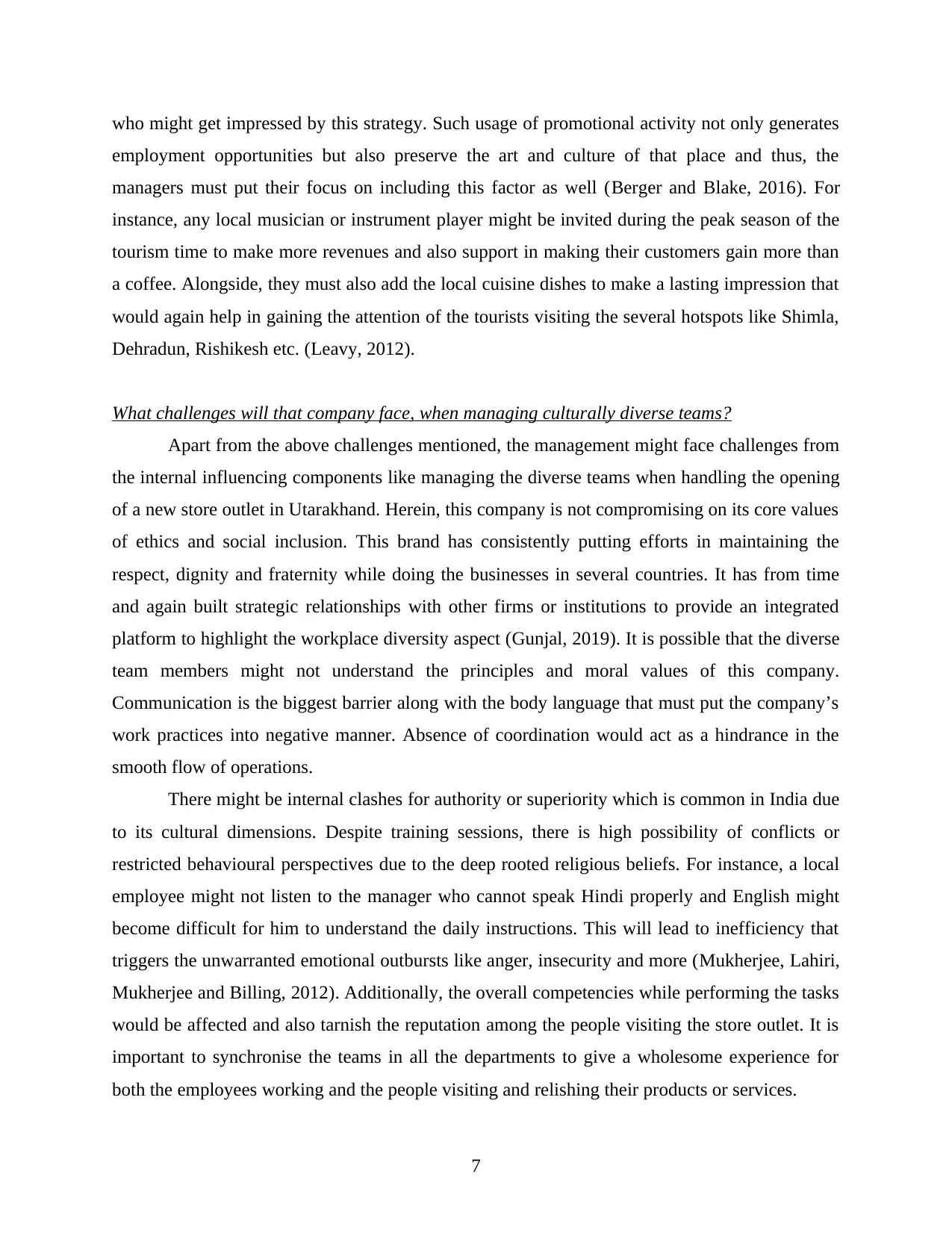
who might get impressed by this strategy. Such usage of promotional activity not only generates
employment opportunities but also preserve the art and culture of that place and thus, the
managers must put their focus on including this factor as well (Berger and Blake, 2016). For
instance, any local musician or instrument player might be invited during the peak season of the
tourism time to make more revenues and also support in making their customers gain more than
a coffee. Alongside, they must also add the local cuisine dishes to make a lasting impression that
would again help in gaining the attention of the tourists visiting the several hotspots like Shimla,
Dehradun, Rishikesh etc. (Leavy, 2012).
What challenges will that company face, when managing culturally diverse teams?
Apart from the above challenges mentioned, the management might face challenges from
the internal influencing components like managing the diverse teams when handling the opening
of a new store outlet in Utarakhand. Herein, this company is not compromising on its core values
of ethics and social inclusion. This brand has consistently putting efforts in maintaining the
respect, dignity and fraternity while doing the businesses in several countries. It has from time
and again built strategic relationships with other firms or institutions to provide an integrated
platform to highlight the workplace diversity aspect (Gunjal, 2019). It is possible that the diverse
team members might not understand the principles and moral values of this company.
Communication is the biggest barrier along with the body language that must put the company’s
work practices into negative manner. Absence of coordination would act as a hindrance in the
smooth flow of operations.
There might be internal clashes for authority or superiority which is common in India due
to its cultural dimensions. Despite training sessions, there is high possibility of conflicts or
restricted behavioural perspectives due to the deep rooted religious beliefs. For instance, a local
employee might not listen to the manager who cannot speak Hindi properly and English might
become difficult for him to understand the daily instructions. This will lead to inefficiency that
triggers the unwarranted emotional outbursts like anger, insecurity and more (Mukherjee, Lahiri,
Mukherjee and Billing, 2012). Additionally, the overall competencies while performing the tasks
would be affected and also tarnish the reputation among the people visiting the store outlet. It is
important to synchronise the teams in all the departments to give a wholesome experience for
both the employees working and the people visiting and relishing their products or services.
7
employment opportunities but also preserve the art and culture of that place and thus, the
managers must put their focus on including this factor as well (Berger and Blake, 2016). For
instance, any local musician or instrument player might be invited during the peak season of the
tourism time to make more revenues and also support in making their customers gain more than
a coffee. Alongside, they must also add the local cuisine dishes to make a lasting impression that
would again help in gaining the attention of the tourists visiting the several hotspots like Shimla,
Dehradun, Rishikesh etc. (Leavy, 2012).
What challenges will that company face, when managing culturally diverse teams?
Apart from the above challenges mentioned, the management might face challenges from
the internal influencing components like managing the diverse teams when handling the opening
of a new store outlet in Utarakhand. Herein, this company is not compromising on its core values
of ethics and social inclusion. This brand has consistently putting efforts in maintaining the
respect, dignity and fraternity while doing the businesses in several countries. It has from time
and again built strategic relationships with other firms or institutions to provide an integrated
platform to highlight the workplace diversity aspect (Gunjal, 2019). It is possible that the diverse
team members might not understand the principles and moral values of this company.
Communication is the biggest barrier along with the body language that must put the company’s
work practices into negative manner. Absence of coordination would act as a hindrance in the
smooth flow of operations.
There might be internal clashes for authority or superiority which is common in India due
to its cultural dimensions. Despite training sessions, there is high possibility of conflicts or
restricted behavioural perspectives due to the deep rooted religious beliefs. For instance, a local
employee might not listen to the manager who cannot speak Hindi properly and English might
become difficult for him to understand the daily instructions. This will lead to inefficiency that
triggers the unwarranted emotional outbursts like anger, insecurity and more (Mukherjee, Lahiri,
Mukherjee and Billing, 2012). Additionally, the overall competencies while performing the tasks
would be affected and also tarnish the reputation among the people visiting the store outlet. It is
important to synchronise the teams in all the departments to give a wholesome experience for
both the employees working and the people visiting and relishing their products or services.
7
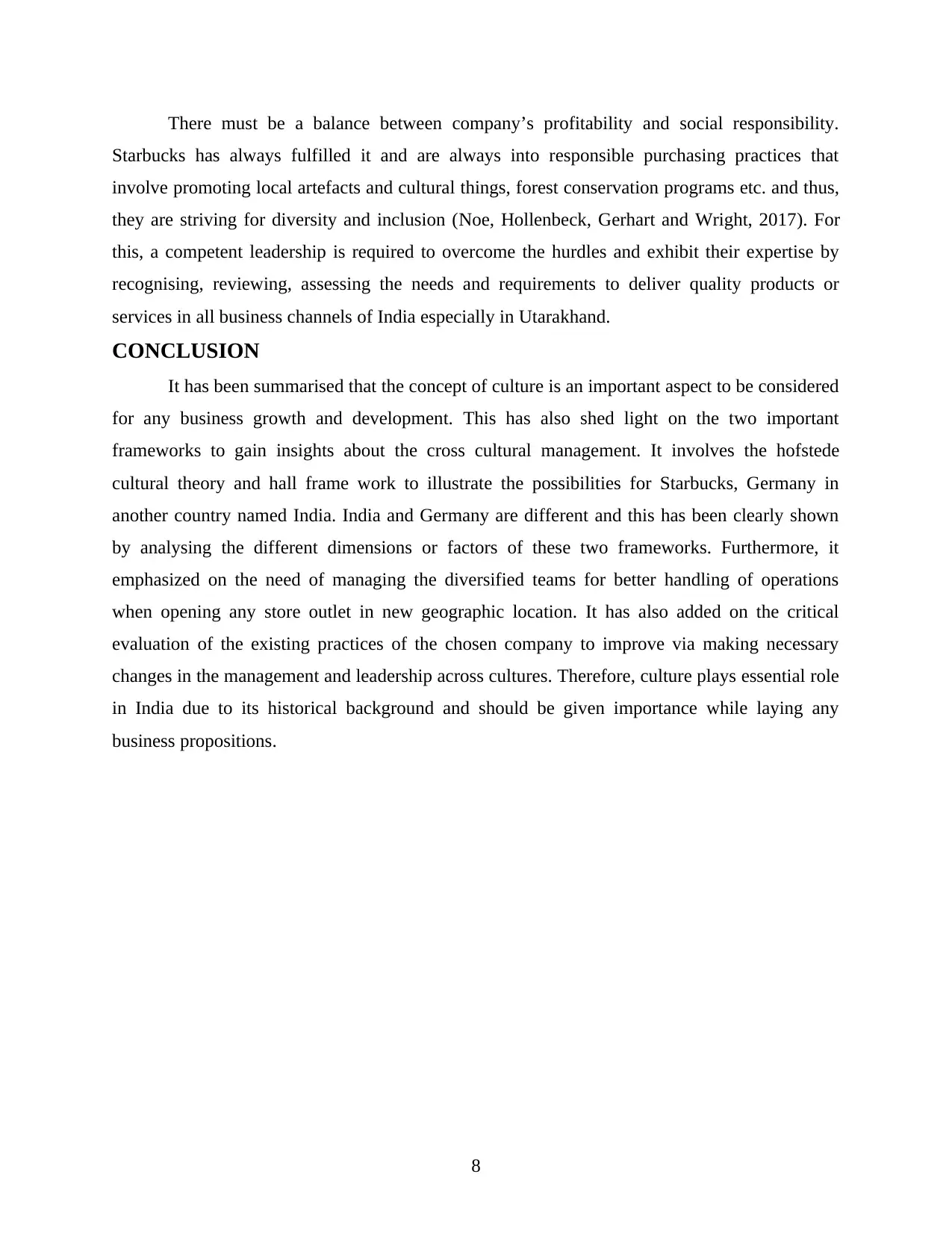
There must be a balance between company’s profitability and social responsibility.
Starbucks has always fulfilled it and are always into responsible purchasing practices that
involve promoting local artefacts and cultural things, forest conservation programs etc. and thus,
they are striving for diversity and inclusion (Noe, Hollenbeck, Gerhart and Wright, 2017). For
this, a competent leadership is required to overcome the hurdles and exhibit their expertise by
recognising, reviewing, assessing the needs and requirements to deliver quality products or
services in all business channels of India especially in Utarakhand.
CONCLUSION
It has been summarised that the concept of culture is an important aspect to be considered
for any business growth and development. This has also shed light on the two important
frameworks to gain insights about the cross cultural management. It involves the hofstede
cultural theory and hall frame work to illustrate the possibilities for Starbucks, Germany in
another country named India. India and Germany are different and this has been clearly shown
by analysing the different dimensions or factors of these two frameworks. Furthermore, it
emphasized on the need of managing the diversified teams for better handling of operations
when opening any store outlet in new geographic location. It has also added on the critical
evaluation of the existing practices of the chosen company to improve via making necessary
changes in the management and leadership across cultures. Therefore, culture plays essential role
in India due to its historical background and should be given importance while laying any
business propositions.
8
Starbucks has always fulfilled it and are always into responsible purchasing practices that
involve promoting local artefacts and cultural things, forest conservation programs etc. and thus,
they are striving for diversity and inclusion (Noe, Hollenbeck, Gerhart and Wright, 2017). For
this, a competent leadership is required to overcome the hurdles and exhibit their expertise by
recognising, reviewing, assessing the needs and requirements to deliver quality products or
services in all business channels of India especially in Utarakhand.
CONCLUSION
It has been summarised that the concept of culture is an important aspect to be considered
for any business growth and development. This has also shed light on the two important
frameworks to gain insights about the cross cultural management. It involves the hofstede
cultural theory and hall frame work to illustrate the possibilities for Starbucks, Germany in
another country named India. India and Germany are different and this has been clearly shown
by analysing the different dimensions or factors of these two frameworks. Furthermore, it
emphasized on the need of managing the diversified teams for better handling of operations
when opening any store outlet in new geographic location. It has also added on the critical
evaluation of the existing practices of the chosen company to improve via making necessary
changes in the management and leadership across cultures. Therefore, culture plays essential role
in India due to its historical background and should be given importance while laying any
business propositions.
8
Secure Best Marks with AI Grader
Need help grading? Try our AI Grader for instant feedback on your assignments.
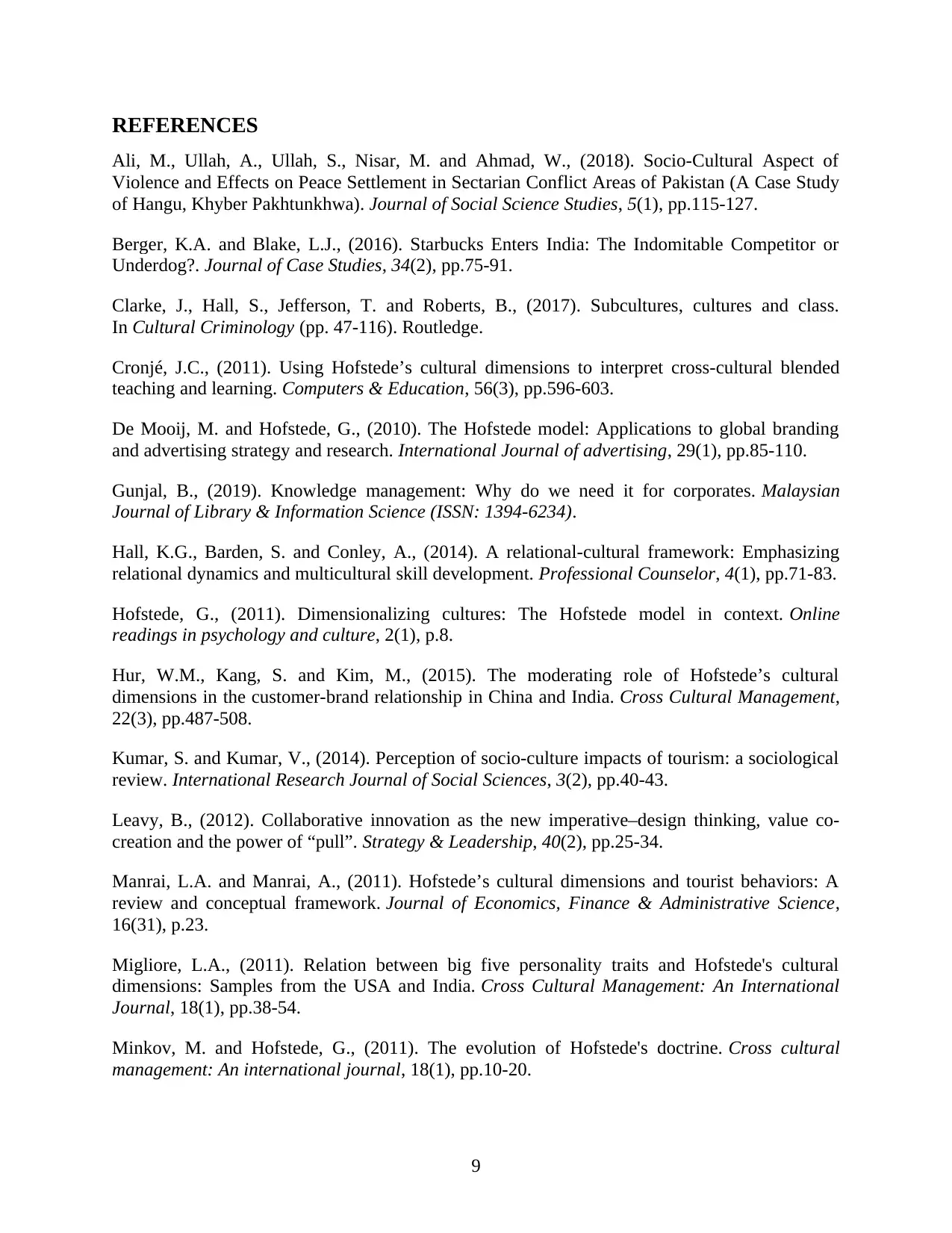
REFERENCES
Ali, M., Ullah, A., Ullah, S., Nisar, M. and Ahmad, W., (2018). Socio-Cultural Aspect of
Violence and Effects on Peace Settlement in Sectarian Conflict Areas of Pakistan (A Case Study
of Hangu, Khyber Pakhtunkhwa). Journal of Social Science Studies, 5(1), pp.115-127.
Berger, K.A. and Blake, L.J., (2016). Starbucks Enters India: The Indomitable Competitor or
Underdog?. Journal of Case Studies, 34(2), pp.75-91.
Clarke, J., Hall, S., Jefferson, T. and Roberts, B., (2017). Subcultures, cultures and class.
In Cultural Criminology (pp. 47-116). Routledge.
Cronjé, J.C., (2011). Using Hofstede’s cultural dimensions to interpret cross-cultural blended
teaching and learning. Computers & Education, 56(3), pp.596-603.
De Mooij, M. and Hofstede, G., (2010). The Hofstede model: Applications to global branding
and advertising strategy and research. International Journal of advertising, 29(1), pp.85-110.
Gunjal, B., (2019). Knowledge management: Why do we need it for corporates. Malaysian
Journal of Library & Information Science (ISSN: 1394-6234).
Hall, K.G., Barden, S. and Conley, A., (2014). A relational-cultural framework: Emphasizing
relational dynamics and multicultural skill development. Professional Counselor, 4(1), pp.71-83.
Hofstede, G., (2011). Dimensionalizing cultures: The Hofstede model in context. Online
readings in psychology and culture, 2(1), p.8.
Hur, W.M., Kang, S. and Kim, M., (2015). The moderating role of Hofstede’s cultural
dimensions in the customer-brand relationship in China and India. Cross Cultural Management,
22(3), pp.487-508.
Kumar, S. and Kumar, V., (2014). Perception of socio-culture impacts of tourism: a sociological
review. International Research Journal of Social Sciences, 3(2), pp.40-43.
Leavy, B., (2012). Collaborative innovation as the new imperative–design thinking, value co-
creation and the power of “pull”. Strategy & Leadership, 40(2), pp.25-34.
Manrai, L.A. and Manrai, A., (2011). Hofstede’s cultural dimensions and tourist behaviors: A
review and conceptual framework. Journal of Economics, Finance & Administrative Science,
16(31), p.23.
Migliore, L.A., (2011). Relation between big five personality traits and Hofstede's cultural
dimensions: Samples from the USA and India. Cross Cultural Management: An International
Journal, 18(1), pp.38-54.
Minkov, M. and Hofstede, G., (2011). The evolution of Hofstede's doctrine. Cross cultural
management: An international journal, 18(1), pp.10-20.
9
Ali, M., Ullah, A., Ullah, S., Nisar, M. and Ahmad, W., (2018). Socio-Cultural Aspect of
Violence and Effects on Peace Settlement in Sectarian Conflict Areas of Pakistan (A Case Study
of Hangu, Khyber Pakhtunkhwa). Journal of Social Science Studies, 5(1), pp.115-127.
Berger, K.A. and Blake, L.J., (2016). Starbucks Enters India: The Indomitable Competitor or
Underdog?. Journal of Case Studies, 34(2), pp.75-91.
Clarke, J., Hall, S., Jefferson, T. and Roberts, B., (2017). Subcultures, cultures and class.
In Cultural Criminology (pp. 47-116). Routledge.
Cronjé, J.C., (2011). Using Hofstede’s cultural dimensions to interpret cross-cultural blended
teaching and learning. Computers & Education, 56(3), pp.596-603.
De Mooij, M. and Hofstede, G., (2010). The Hofstede model: Applications to global branding
and advertising strategy and research. International Journal of advertising, 29(1), pp.85-110.
Gunjal, B., (2019). Knowledge management: Why do we need it for corporates. Malaysian
Journal of Library & Information Science (ISSN: 1394-6234).
Hall, K.G., Barden, S. and Conley, A., (2014). A relational-cultural framework: Emphasizing
relational dynamics and multicultural skill development. Professional Counselor, 4(1), pp.71-83.
Hofstede, G., (2011). Dimensionalizing cultures: The Hofstede model in context. Online
readings in psychology and culture, 2(1), p.8.
Hur, W.M., Kang, S. and Kim, M., (2015). The moderating role of Hofstede’s cultural
dimensions in the customer-brand relationship in China and India. Cross Cultural Management,
22(3), pp.487-508.
Kumar, S. and Kumar, V., (2014). Perception of socio-culture impacts of tourism: a sociological
review. International Research Journal of Social Sciences, 3(2), pp.40-43.
Leavy, B., (2012). Collaborative innovation as the new imperative–design thinking, value co-
creation and the power of “pull”. Strategy & Leadership, 40(2), pp.25-34.
Manrai, L.A. and Manrai, A., (2011). Hofstede’s cultural dimensions and tourist behaviors: A
review and conceptual framework. Journal of Economics, Finance & Administrative Science,
16(31), p.23.
Migliore, L.A., (2011). Relation between big five personality traits and Hofstede's cultural
dimensions: Samples from the USA and India. Cross Cultural Management: An International
Journal, 18(1), pp.38-54.
Minkov, M. and Hofstede, G., (2011). The evolution of Hofstede's doctrine. Cross cultural
management: An international journal, 18(1), pp.10-20.
9
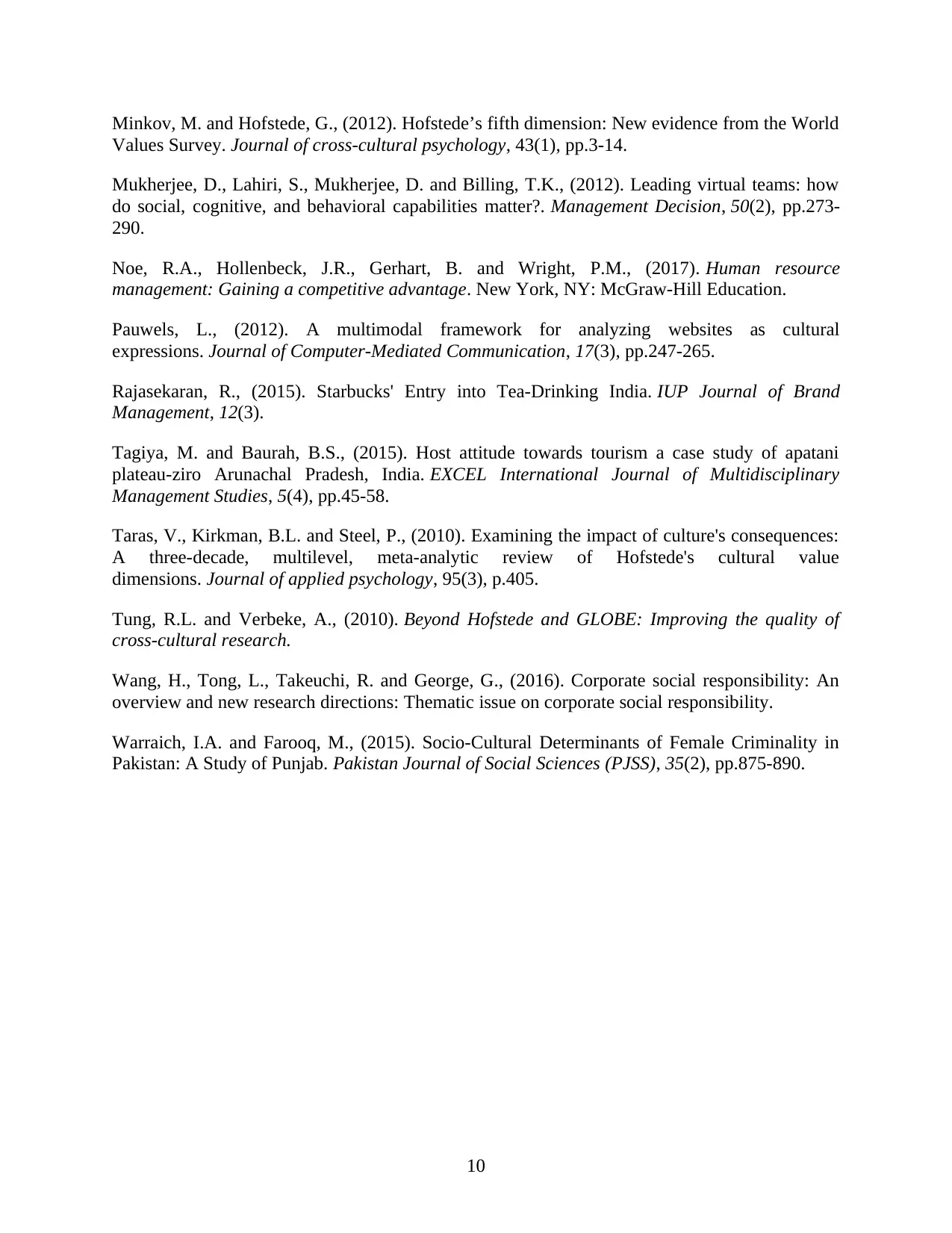
Minkov, M. and Hofstede, G., (2012). Hofstede’s fifth dimension: New evidence from the World
Values Survey. Journal of cross-cultural psychology, 43(1), pp.3-14.
Mukherjee, D., Lahiri, S., Mukherjee, D. and Billing, T.K., (2012). Leading virtual teams: how
do social, cognitive, and behavioral capabilities matter?. Management Decision, 50(2), pp.273-
290.
Noe, R.A., Hollenbeck, J.R., Gerhart, B. and Wright, P.M., (2017). Human resource
management: Gaining a competitive advantage. New York, NY: McGraw-Hill Education.
Pauwels, L., (2012). A multimodal framework for analyzing websites as cultural
expressions. Journal of Computer-Mediated Communication, 17(3), pp.247-265.
Rajasekaran, R., (2015). Starbucks' Entry into Tea-Drinking India. IUP Journal of Brand
Management, 12(3).
Tagiya, M. and Baurah, B.S., (2015). Host attitude towards tourism a case study of apatani
plateau-ziro Arunachal Pradesh, India. EXCEL International Journal of Multidisciplinary
Management Studies, 5(4), pp.45-58.
Taras, V., Kirkman, B.L. and Steel, P., (2010). Examining the impact of culture's consequences:
A three-decade, multilevel, meta-analytic review of Hofstede's cultural value
dimensions. Journal of applied psychology, 95(3), p.405.
Tung, R.L. and Verbeke, A., (2010). Beyond Hofstede and GLOBE: Improving the quality of
cross-cultural research.
Wang, H., Tong, L., Takeuchi, R. and George, G., (2016). Corporate social responsibility: An
overview and new research directions: Thematic issue on corporate social responsibility.
Warraich, I.A. and Farooq, M., (2015). Socio-Cultural Determinants of Female Criminality in
Pakistan: A Study of Punjab. Pakistan Journal of Social Sciences (PJSS), 35(2), pp.875-890.
10
Values Survey. Journal of cross-cultural psychology, 43(1), pp.3-14.
Mukherjee, D., Lahiri, S., Mukherjee, D. and Billing, T.K., (2012). Leading virtual teams: how
do social, cognitive, and behavioral capabilities matter?. Management Decision, 50(2), pp.273-
290.
Noe, R.A., Hollenbeck, J.R., Gerhart, B. and Wright, P.M., (2017). Human resource
management: Gaining a competitive advantage. New York, NY: McGraw-Hill Education.
Pauwels, L., (2012). A multimodal framework for analyzing websites as cultural
expressions. Journal of Computer-Mediated Communication, 17(3), pp.247-265.
Rajasekaran, R., (2015). Starbucks' Entry into Tea-Drinking India. IUP Journal of Brand
Management, 12(3).
Tagiya, M. and Baurah, B.S., (2015). Host attitude towards tourism a case study of apatani
plateau-ziro Arunachal Pradesh, India. EXCEL International Journal of Multidisciplinary
Management Studies, 5(4), pp.45-58.
Taras, V., Kirkman, B.L. and Steel, P., (2010). Examining the impact of culture's consequences:
A three-decade, multilevel, meta-analytic review of Hofstede's cultural value
dimensions. Journal of applied psychology, 95(3), p.405.
Tung, R.L. and Verbeke, A., (2010). Beyond Hofstede and GLOBE: Improving the quality of
cross-cultural research.
Wang, H., Tong, L., Takeuchi, R. and George, G., (2016). Corporate social responsibility: An
overview and new research directions: Thematic issue on corporate social responsibility.
Warraich, I.A. and Farooq, M., (2015). Socio-Cultural Determinants of Female Criminality in
Pakistan: A Study of Punjab. Pakistan Journal of Social Sciences (PJSS), 35(2), pp.875-890.
10
1 out of 12
Your All-in-One AI-Powered Toolkit for Academic Success.
+13062052269
info@desklib.com
Available 24*7 on WhatsApp / Email
![[object Object]](/_next/static/media/star-bottom.7253800d.svg)
Unlock your academic potential
© 2024 | Zucol Services PVT LTD | All rights reserved.


